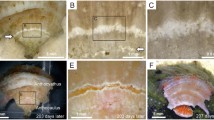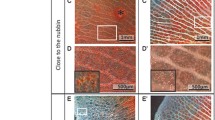Abstract
Skeletogenesis in the hermatypic coral Stylophora pistillata was studied by using the lateral skeleton preparative (LSP) assay, viz., a coral nubbin attached to a glass coverslip glued to the bottom of a Petri dish. Observations on tissue and skeletal growth were made by polarized microscopy and by using vital staining. The horizontal distal tissue edges developed thin transparent extensions of ectodermal and calicoblastic layers only. Four stages (I-IV) of skeletogenesis were observed at these edges, underneath the newly developed tissue. In stage I, a thin clear layer of coral tissue advanced 3–40 μm beyond the existing LSP peripheral zone, revealing no sign of spiculae deposition. At stage II, primary fusiform crystals (1 μm each) were deposited, forming a primary discontinuous skeletal front 5–30 μm away from the previously deposited skeleton. During stage III, needle-like crystals appeared, covering the primary fusiform crystals. Stage IV involved further lengthening of the needle-like crystals, a process that resulted in occlusion of the spaces between adjacent crystals. Calcification stages I-III developed within hours, whereas stage IV was completed in several days to weeks. Two basic skeletal structures, “scattered” and “laminar” skeletons, were formed, integrating the growth patterns of the needle-like crystals. High variation was recorded in the expression of the four calcification stages, either between different locations along a single LSP or between different preparations observed at the same diurnal time. All four skeletogenesis stages took place during both day and night periods, indicating that an intrinsic process controls S. pistillata calcification.



Similar content being viewed by others
References
Allemand D, Furla P, Bénazet-Tambutté S (1998) Mechanisms of carbon acquisition for endosymbiont photosynthesis in Anthozoa. Can J Bot 76:925–941
Al-Horani FA, Al-Moghrabi SM, Beer D de (2003) Microsensor study of photosynthesis and calcification in the scleractinian coral, Galaxea fascicularis: active internal carbon cycle. J Exp Mar Biol Ecol 288:1–15
Barnes DJ (1970) Coral skeletons: an explanation of their growth and structure. Science 170:1305–1308
Barnes DJ (1972) The structure and function of growth ridges in scleractinian coral skeletons. Proc R Soc Lond (Biol) 182:331–350
Chalker BE, Taylor DL (1975) Light enhanced calcification, and the role of oxidative phosphorylation in calcification of the coral Acropora cervicornis. Proc R Soc Lond (Biol) 190:323–331
Clode PL, Marshall AT (2003a) Skeletal microstructure of Galaxea fascicularis exert septa: a high-resolution SEM study. Biol Bull 204:146–154
Clode PL, Marshall AT (2003b) Calcium associated with a fibrillar organic matrix in the scleractinian coral Galaxea fascicularis. Protoplasma 220:153–161
Constantz BR (1986) Coral skeleton construction: a physiochemically dominated process. Palaios 1:152–157
Constantz BR (1989) Skeletal organization in Caribbean Acropora spp. (Lamarck). In: Crick RE (ed) Origin evolution and modern aspects of biomineralization in plants and animals. Plenum, New York, pp 175–199
Cuif JP, Dauphin Y (2005) The two-step mode of growth in the scleractinian coral skeletons from the micrometer to the overall scale. J Struct Biol 150:319–331
Cuif JP, Dauphin Y, Gautert P (1999) Compositional diversity of soluble mineralizing matrices in some recent coral skeletons compared to fine-scale growth structures of fibers: discussion of consequences for biomineralization and diagenesis. Int J Earth Sci 88:582–592
Furla P, Galgani I, Durand I, Allemand D (2000) Sources and mechanisms of inorganic carbon transport for coral calcification and photosynthesis. J Exp Biol 203:3445–3457
Gattuso JP, Allemand D, Frankignoulle M (1999) Photosynthesis and calcification at cellular, organismal and community levels in coral reefs: a review on interaction and control by carbonate chemistry. Am Zool 39:160–183
Gladfelter EH (1982) Skeletal development in Acropora cervicornis. I. Pattern of calcium carbonate accretion in the axial corallite. Coral Reefs 1:45–51
Gladfelter EH (1983) Skeletal development in Acropora cervicornis. II. Diel pattern of calcium carbonate accretion. Coral Reefs 2:91–100
Goreau TF (1959) The physiology of skeleton formation in corals. I. A method for measuring the rate of calcium deposition by corals under different conditions. Biol Bull 116:59–75
Hidaka M (1991) Deposition of fusiform crystals without apparent diurnal rhythm at the growing edge of septa of the coral Galaxea fascicularis. Coral Reefs 10:41–45
Hidaka M, Shirasaka S (1992) Mechanism of phototropism in young corallites of the coral Galaxea fascicularis (L.). J Exp Mar Biol Ecol 157:69–77
Howe SA, Marshall AT (2002) Temperature effects on calcification rate and skeletal deposition in the temperate coral Plesiastrea versipora (Lamark). J Exp Mar Biol Ecol 275:63–81
Isa Y (1986) An electron microscope study on the mineralization of the skeleton of the staghorn coral Acropora hebes. Mar Biol 93:91–101
Johnston IS (1980) The ultrastructure of skeletogenesis in hermatypic corals. Int Rev Cytol 67:171–214
Le Tissier MDÁA (1988) Diurnal patterns of skeleton formation in Pocillopora damicornis (Linnaeus). Coral Reefs 7:81–88
Le Tissier MDÁA (1990) The ultrastructure of the skeleton and skeletogenic tissues of the temperate coral Caryophyllia smithii. J Mar Biol Assoc UK 70:295–310
Le Tissier MDÁA (1991) The nature of the skeleton and skleletonic tissues in the Cnidaria. Hydrobiologia 216/217:397–402
Marin F, Smith M, Isa Y, Muyzer G, Westbroek P (1996) Skeletal matrices, muci, and the origin of invertebrate calcification. Proc Natl Acad Sci USA 93:1554–1559
Marshall AT, Wright OP (1993) Confocal laser scanning light microscopy of extra thecal epithelia of undecalcified scleractinian corals. Cell Tissue Res 272:533–543
Muscatine L (1990) The role of symbiotic algae in carbon and energy flux in reef corals. In: Dubinsky Z, et al (eds) Ecosystems of the world, vol 25. Elsevier, Amsterdam, pp 75–87
Ogilvie M (1896) Microscopic and systematic study of madreporarian types of corals. Philos Trans R Soc Lond Biol 187:85–345
Pearse VB, Muscatine L (1971) Role of symbiotic algae (zooxanthellae) in coral calcification. Biol Bull 141:350–363
Perrin C (2003) Compositional heterogeneity and microstructural diversity of coral skeleton: implications for taxonomy and control on early diagenesis. Coral Reefs 22:109–120
Reynaud-Vaganay S, Gattuso JP, Cuif JP, Jaubert J, Juillet-Leclerc A (1999) A novel culture technique for scleractinian corals: application to investigate changes in skeletal Δ18O as a function of temperature. Mar Ecol Prog Ser 180:121–130
Rinkevich B, Loya Y (1984) Does light enhance calcification in hermatypic corals? Mar Biol 80:1–6
Rowley RJ, Mackinnon DT (1995) Use of the fluorescent marker Calcein in biomineralization studies of brachiopods and other marine organisms. Bull Inst Oceanogr (Monaco) SPEC 14:111–120
Shafir S, Van Rijn J, Rinkevich B (2001) Nubbing of coral colonies: a novel approach for the development of inland bloodstocks. Aquarium Sci Conserv 3:183–190
Shafir S, Van Rijn J, Rinkevich B (2003) The use of coral nubbins in coral reef ecotoxicology testing. Biomol Eng 20:401–406
Simkiss K, Wilbur KM (1989) Biomineralization, cell biology and mineral deposition. Academic Press, San Diego
Vago R, Gill E, Collingwood JC (1997) Laser measurements of coral growth. Nature 386:30–31
Wise SW (1972) Observations of fasciculi on developmental surfaces of scleractinian coral exoskeletons. Biomineralization 6:160–175
Wainwright SA (1963) Skeletal organization in the coral Pocillopora damicornis. Q J Microsc Sci 104:169–183
Wright OP, Marshall AT (1991) Calcium transport across the isolated oral epithelium of scleractinian corals. Coral Reefs 10:37–40
Young SD (1971) Organic material from scleratinian coral skeletons. I. Variation in composition between several species. Comp Biochem Physiol 40B:113–120
Young SD (1973) Calcification and synthesis of skeletal organic material in the coral Pocillopora damicornis. Comp Biochem Physiol 44A:669–672
Acknowledgement
We thank Dr. E. Moisseva for her help with histological sections.
Author information
Authors and Affiliations
Corresponding author
Additional information
This study was supported by the Israel Science Foundation (206/01 to J.E.), by the BARD, US-Israel Bi-National Agricultural Research and Development, by INCO-DEV project (REEFRES), and by CORALZOO, EC Collective Research project.
Rights and permissions
About this article
Cite this article
Raz-Bahat, M., Erez, J. & Rinkevich, B. In vivo light-microscopic documentation for primary calcification processes in the hermatypic coral Stylophora pistillata . Cell Tissue Res 325, 361–368 (2006). https://doi.org/10.1007/s00441-006-0182-8
Received:
Accepted:
Published:
Issue Date:
DOI: https://doi.org/10.1007/s00441-006-0182-8




